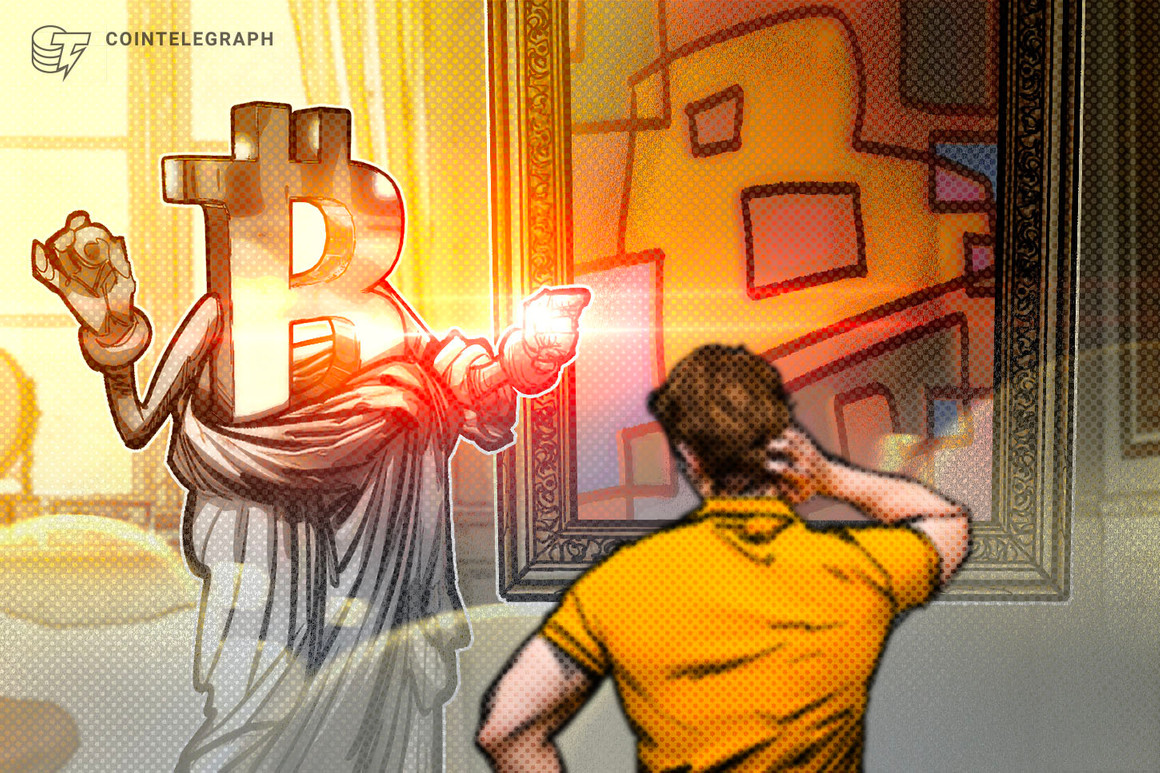Minting a nonfungible token of artwork seems a no-brainer for an artist, and Cointelegraph spoke to those that took the plunge.
“Art is not a thing, it is a way,” said American writer Elbert Hubbard. For Bitcoin (BTC) artists, the way is inspired by Bitcoin, its code, its philosophy and its imagery. In some cases, it’s even inspired by memes. Bitcoin has become a “lifestyle,” for some Bitcoin artists, that inspires their way of doing business, accepting payments and interacting with customers.
Cointelegraph asked Bitcoin artists what inspires them about Satoshi Nakamoto’s 13-year-old invention and whether minting a nonfungible token (NFT) would complement their “way” of doing art. After all, an NFT is a unique, digital receipt to prove ownership of a purchase that lives on a blockchain. Surely artists would want to prove ownership of the art at which they toiled away?
Lena, a Bitcoin artist who recently moved from Germany to crypto-friendly Dubai, began creating, painting and printing Bitcoin artworks after diving down the Bitcoin rabbit hole in 2018. She said that while she started her crypto career as a crypto-agnostic, Bitcoin changed her approach and eventually took over. She now operates a Bitcoin “maxi-style” portfolio:
When speaking with people in the crypto community, she explains she’s a Bitcoin artist, to which crypto-lovers ask, “Oh, so you do NFTs?” She told Cointelegraph she replies with, “No! Physical art!”
However, countless artists make a living generating AI artwork and selling or minting them as NFTs on platforms such as OpenSea. The biggest stories of 2021 involved collective cartoon chimps — Bored Ape Yacht Club — and CryptoPunks, further digitally rendered images or art.
In the 2022 bear market, the hype around NFTs has reportedly evaporated. Yet, big name brands such as Starbucks continue to hop on the bandwagon, while luxury jeweler Tiffany caused a 1,700% increase in trading volume following an NFT move in August.
When Cointelegraph asked FractalEncrypt (an anonymous Bitcoin artist) whether they would release an NFT of their art in the future, they said, “Absolutely not.” FractalEncrypt sculpts large, imposing, time-consuming Bitcoin full node structures, which he has hidden in locations around the world:
The Bitcoin Full Node Sculpture, A Cypherpunk Chronometer.
#5 of 10 was hand delivered yesterday & I wanted to compile a GIGA-THREAD compiling photos, videos, explainers, and podcasts all into one place
Let’s go back into time and down the rabbit hole and see #1 -4 pic.twitter.com/8IcGnl0tyE
FractalEncrypt explained that the link between the art and the token was “ephemeral at best and an outright misrepresentation/fraud at worst.” They compare the issuance of NFTs as akin to centralized companies issuing tokens, which could be problematic and even litigious.
But that doesn’t mean that FractalEncrypt wrote off NFT technology at inception. Like Lena, the two artists were curious about the Ethereum-based technology when it first came along:
Indeed, Wikipedia explains that an NFT is a “financial security consisting of digital data stored in a blockchain.” The United States Securities and Exchange Commission is focused on certain crypto projects during the bear market. At the same time, the case between the SEC and Ripple regarding the latter’s XRP token rages on.
BitcoinArt, who chose to remain anonymous, is among the few Bitcoin artists Cointelegraph spoke to who had also dipped their toes into the world of NFTs. They told Cointelegraph that they did manage to sell a couple of NFTs of their Bitcoin-related artwork but didn’t enjoy the medium or the concept:
A recurring theme by this point, BitcoinArt prefers having one-on-one interactions with prospective customers; he enjoys the back and forth that comes through discussing art pieces.
Lena also prefers the personal approach. She builds a connection with her clients and spends hours sketching, painting and painstakingly perfecting customers’ visions. In Lena’s words, the time spent on her art is a reflection of proof-of-work, the consensus mechanism that underpins the Bitcoin protocol. She told Cointelegraph that the process of creating one art piece is unique and limited — much like Bitcoin — so there’s no need for an NFT. Here Lena makes a statement with one of her pieces:
FractalEncrypt mocked the “high-time preference culture” prescient in NFTs. Indeed, many of the biggest proponents of the CryptoPunks quickly traded allegiance to BAYC before jumping on the next shiny new collection.
Related: NFT art galleries: Future of digital artwork or another crypto fad?
Bitcoin, conversely, is a movement. Lena stated, “Bitcoin changed my way of thinking. Bitcoin changed me. [Learning about Bitcoin] was a very, very meaningful chapter in my life.”
Interestingly, a search for “Bitcoin NFT” on OpenSea yields more than 70,000 items. For Lena, the door is still open: “NFTs could have use cases in the future, but the way that NFTs are right now, it doesn’t feel right,” she conceded. OpenSea has suffered hacks and wash trading, but JPEGs of pixelated images valued at seven figures continue to sell. “It feels like a bubble,” Lena summed up.
Conversely, Bitcoin is down over 50% from its bubbly highs of $69,000, and the “tourists” have checked out. Plus, Bitcoin received as payment for an art piece will likely never be hacked or “drained” from a wallet.


